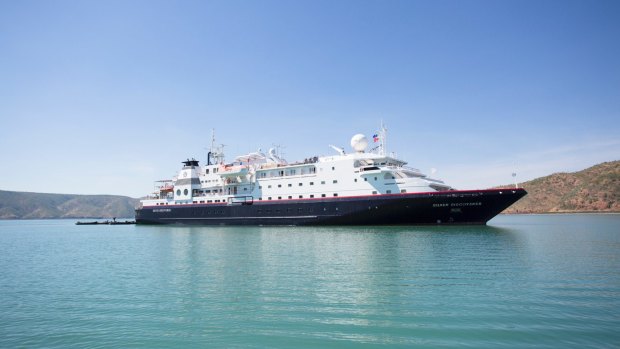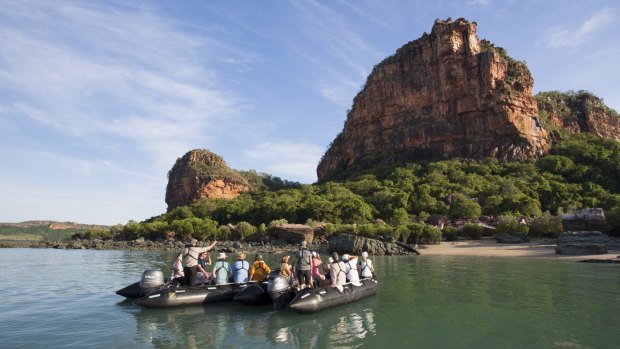This was published 6 years ago
Cruising the wild and remote Kimberley coast with Silversea
By Andrew Bain

The Silver Discoverer is the second-smallest vessel in Silversea's fleet of 10 cruise ships, with capacity for 120 guests.
It's as though the land is drinking the ocean. The tide is receding so fast that water pours off the reef, splashing over the backs of turtles and the passing fin of a shark. In just a couple of hours, around 400 square kilometres of reef will be exposed.
Sir David Attenborough has called Montgomery Reef "one of the greatest natural wonders of the world", and here, in a Zodiac in a channel that splits the reef, it's like watching a submarine the size of a mini-continent surfacing from the Indian Ocean.
Across the water, our ship, the Silver Discoverer, waits on the horizon, and beyond it is the red line of Western Australia's empty Kimberley coast. As the tide continues to fall, a sandbar emerges at the edge of the reef. By the time we've finished exploring the reef, the ship's crew have laid claim to the sandbar, setting up a bar under a beach gazebo, making this "sandbar" literal. Fifteen kilometres out to sea, on a swoosh of sand that appears on no map, we sip cocktails and I think that, once again, Attenborough knew what he was talking about.

Silversea Zodiac excursion in the Kimberley.
It's been three days since the Silver Discoverer sailed out from Broome for a journey along the wild and remote Kimberley coast, detouring north to a deserted East Timor island and finally into Darwin. It's slow-motion, expedition cruising – the Silver Discoverer as a luxurious water taxi, poking into places larger ships can't access, staying for hours or a day while Zodiacs fan out deeper into the shores and estuaries.
On board are just 106 passengers, and almost 100 crew members. It's personal, adventurous and exploratory, as feels appropriate along this coast where nature lives on so strong. Crocodiles cruise the waterways, tawny nurse sharks circle the ship almost every time we anchor, and a forecast cyclone hovers just out of sight but never far from mind.
What makes the Kimberley coast so compelling is that it feels virtually beyond humanity. Between Derby and Wyndham, a stretch of coast thousands of kilometres in length, barely a road reaches the sea. The human reminders come in the form of ancient Aboriginal rock art, but otherwise it's a place where thunderous waterfalls dive over red cliffs, where ocean tides surge violently through narrow gaps, and where a reef can emerge and submerge like a twice-daily heartbeat.
Each day of cruising and exploration here is determined by the tides – a return to natural rhythms in this region with one of the world's highest tidal ranges. If the 10-plus-metre tidal surge is obvious at Montgomery Reef, it's almost overwhelming at the Horizontal Waterfalls.
The "waterfalls" are our first stop out of Broome, as we wake to the ship threading between the 800 islands of the Buccaneer Archipelago before anchoring in Talbot Bay. Boarding a 900-horsepower fast boat, we head for the Horizontal Waterfalls, where the tides squeeze through two narrow gaps in the cliffs, creating a stampede of water – up to one million litres of ocean sucking through a space just a few metres wide every second.
"This is the most dangerous current in the Kimberley," says the boat's skipper, Adrian, as we idle at the mouth of the first gap. "It's wrecked hundreds of boats. I've rescued a few."
This is of course a prelude to Adrian gunning the boat and powering us into the gap. It's a neap tide – a tidal variation of about four metres instead of 11 or 12 metres – so it's a scale-model version of the full fury of the Horizontal Waterfalls, but still the sea bucks and kicks at the boat as a maelstrom of water surges through the gap.
Almost every day is an exciting version-of-sorts of this day. There will be hours spent in Zodiacs, with crocodiles sliding past almost in arm's reach as we explore river systems, coastlines and Montgomery Reef. There's the option of a helicopter flight to Mitchell Falls, a sightseeing plane flight over the surreal landscape of the Bungle Bungles, a day of snorkelling over a teeming ribbon of reef on East Timor's Jaco Island, and time on foot exploring the many wonders of the strikingly beautiful Kimberley coastline.
"I've worked all over the world – Papua New Guinea, Kamchatka, the Arctic – and the Kimberley is by far my favourite place," says Brad Siviour, the Silver Discoverer's expedition team leader.
They're adventurous days that are well and truly tempered by the quiet decadence of ship life. The Silver Discoverer is the second-smallest vessel in Silversea's fleet of 10 cruise ships, with capacity of just 120 guests. With a crew-to-guest ratio of almost one-to-one, it's a personal and personable journey.
Every suite has butler service, and the rigours of the days disappear among the poolside cocktails, the ship sommelier, the high teas, and the menus created in partnership with Relais & Chateaux.
Each evening there's a recap of the day, a briefing about the coming day, and presentations by expedition staff and the ship's guest lecturer, Oxford Emeritus Professor in Geography, Andrew Goudie, an expert in Kimberley geology.
The dinner and evening mood is primarily casual. There are nights I dine out on the open pool deck, where steak and seafood is cooked on hot rocks as the Indian Ocean or Timor Sea slide beneath us.
The most significant human marks on the Kimberley coast are Aboriginal, and the day after leaving the Horizontal Waterfalls, we wake at Raft Point, where toothy cliffs rise from the flat ocean. Among the cliffs is Ngumbre, a sandstone overhang emblazoned with Wandjina art. It's one of two rock-art sites we'll visit over the coming days.
This style of Kimberley art came to prominence when the distinctive Wandjina figure appeared in the opening ceremony of the Sydney Olympics. The Worrora man who created the figure was Donny Woolagoodja, the custodian of the Ngumbre paintings.
On the beach beneath the cliffs, we're welcomed to country with a smear of ochre on each cheek before making a loose, stony climb to the base of the cliffs. Around us, boab trees bulge out of the slopes, and the cliffs of Raft Point Bluff seem to saw at the sky. Beneath the overhang, two young Worrora men, including Woolagoodja's grandson Callum, guide us through the art and its meaning.
Once thought by outsiders to be paintings of aliens, the Wandjina figures are of far greater significance. "The Wandjina are like our god," Callum tells us.
To the Worrora people, the Wandjina control the life-giving weather and seasons. Emblazoned brightly across the ceiling of the overhang is the largest of the Wandjina figures, an ancient figure repainted by Woolagoodja last year, an act that preceded – or heralded – one of the wettest monsoon seasons across the Kimberley on record.
It was this prodigious rainfall that would create the grandest moment of our journey. Splitting the Kimberley coast near its northernmost tip is the King George River, where the King George Falls pour like a wishbone of water off the Kimberley Plateau. After such a wet season, we're anticipating a natural show of power.
The Silver Discoverer anchors in the early morning in Koolama Bay, and by 6am the Zodiacs are bouncing across the bay towards the mouth of the King George River. Geometrically perfect red cliffs rear up from the river as Jenga-like blocks of rock.
At a confluence a short way along the river, we turn up into a tributary, coming to its navigable end a few hundred metres upstream where a 20-metre-high waterfall rushes over the red cliffs.
"This one's just a tiddler," says expedition guide Mike Cusack. "It doesn't even have a name." The suspense is well and truly set for the King George Falls ahead, through the ever-narrowing gorge.
As we near the falls, which split into two around a promontory of rock, it's like approaching a storm. The noise is like thunder, and the winds it generates are almost cyclonic.
We pull ashore downstream and climb steeply to the head of the waterfall and a gloriously cool waterhole just a few steps from where the falls make their 100-metre-high plunge. It's like an infinity pool with one of the most dramatic views in the country.
As we push off in the Zodiacs again a couple of hours later, we aren't returning immediately to the ship. Instead we skim across to the base of the least powerful of the two falls, nosing the Zodiac beneath them. A torrential shower floods over our shoulders and heads – luxury, in its most natural and delightful form, pouring over us.
Qantas has direct flights to and from Broome and Darwin, the start and finish points of the cruise, from both Sydney and Melbourne. qantas.com
CRUISING THERE
The Silver Discoverer will operate between Broome and Darwin from July to August 2018. All-inclusive cruise and air package fares on the 10-day expedition cruise begin from $11,340. silversea.com
Andrew Bain travelled courtesy of Silversea.
FIVE OTHER SILVER DISCOVERY STOPS
MITCHELL FALLS
An optional extra of a helicopter flight over the Kimberley Plateau to the edge of the north-west's signature waterfall, with the chance of a swim above the falls.
JAR ISLAND
Small island in remote Vansittart Bay containing galleries of the Kimberley's mysterious and intricate Gwion Gwion rock art – its origins are unknown.
BUNGLE BUNGLES
Light-aircraft flight over Lake Argyle and the Argyle Diamond Mine to the curious shapes of Purnululu National Park.
HUNTER RIVER
A back-to-wilds Zodiac journey along the mangrove lined Hunter River and its Porosus River tributary, which takes its title from the scientific name for the estuarine crocodile: Crocodylus porosus. Get the picture ...
JACO ISLAND (EAST TIMOR)
Uninhabited island national park off Timor's eastern tip. Steps from its beach is a narrow reef prolific in marine life.
Sign up for the Traveller Deals newsletter
Get exclusive travel deals delivered straight to your inbox. Sign up now.